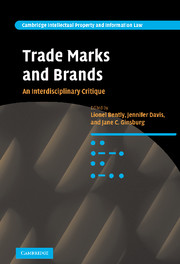Book contents
- Frontmatter
- Contents
- List of figures and tables
- Notes on the contributors
- Editors' preface
- Table of cases
- Table of statutes
- Part I Legal and economic history
- 1 The making of modern trade mark law: the construction of the legal concept of trade mark (1860–1880)
- 2 The making of modern trade mark law: the UK, 1860–1914. A business history perspective
- Part II Current positive law in the EU and the USA
- Part III Linguistics
- Part IV Marketing
- Part V Sociology
- Part VI Law and Economics
- Part VII Philosophy
- Part VIII Anthropology
- Part IX Geography
- Bibliography
- Index
- Titles in the series
1 - The making of modern trade mark law: the construction of the legal concept of trade mark (1860–1880)
Published online by Cambridge University Press: 13 April 2010
- Frontmatter
- Contents
- List of figures and tables
- Notes on the contributors
- Editors' preface
- Table of cases
- Table of statutes
- Part I Legal and economic history
- 1 The making of modern trade mark law: the construction of the legal concept of trade mark (1860–1880)
- 2 The making of modern trade mark law: the UK, 1860–1914. A business history perspective
- Part II Current positive law in the EU and the USA
- Part III Linguistics
- Part IV Marketing
- Part V Sociology
- Part VI Law and Economics
- Part VII Philosophy
- Part VIII Anthropology
- Part IX Geography
- Bibliography
- Index
- Titles in the series
Summary
Although some accounts of the history of trade mark law trace the origin of trade mark protection to Greek or Roman times, and other accounts of the British history locate the origins of British trade mark law in the medieval guilds, or the sixteenth-century case of JG v Samford, British trade mark law did not really take anything like its modern shape until the latter half of the nineteenth century. The period between 1860 and 1910 witnessed the development of many of the characteristic features of modern trade mark law: a legal understanding of a trade mark as a sign which indicates trade origin; the establishment of a central registry in 1876; the conceptualization of the trade mark as an object of property; the recognition of a dual system of protection: one based on registration, the other based on use in the marketplace; and the development of international arrangements for the protection of marks in foreign territories. Looking back from the early twenty-first century, it is clear that, while there were significant developments in trade mark law in the period before 1860 and the period after 1910, the majority of the most salient features of the current trade mark regime were developed (or if not developed, institutionalized) in this period of intense legislative, judicial, diplomatic and scholarly activity.
- Type
- Chapter
- Information
- Trade Marks and BrandsAn Interdisciplinary Critique, pp. 3 - 41Publisher: Cambridge University PressPrint publication year: 2008
- 28
- Cited by



